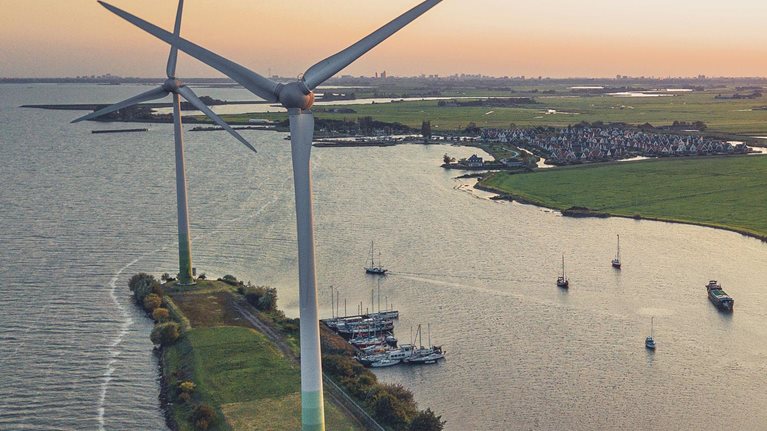Sustainability has increasingly become a key focus for many mining companies and their shareholders, for whom monitoring greenhouse gas (GHG) emissions is critically important due to their global warming potential. Mining companies must understand not only shifts in demand for their metals and minerals, but also the direct and indirect emissions that arise from mining, hauling, processing, and transporting the commodities they produce and sell.
Although some commodities are more carbon-intensive by nature (Exhibit 1), public and private stakeholders across all commodities demand greater environmental and social consciousness. Similarly, all mining companies will have their operation costs increasingly impacted by policies like carbon prices in the future.1 A recent McKinsey study found that Scope 1 and 2 emissions from the mining industry as a whole totaled two billion metric tons (MT; 1 MT = 2,205 pounds) of carbon dioxide equivalent (CO2e) in 2018. The carbon intensity and decarbonization challenges for individual companies will vary, with physical characteristics of deposits like depth and ore grade driving key energy, logistics, and process levers, as well as fugitive emissions.

To exemplify some of the particularities of each market, using MineSpans CO2 Emissions Tool2 we analyzed three commodity sectors: metallurgical coal and iron ore as raw materials for steel making, the largest metals sector; and nickel, which is expected to become increasingly important in the energy transition as a raw material for lithium-ion batteries. End consumers of nickel have made news recently for applying pressure to decarbonize, after Tesla's Elon Musk stated that he would award a “giant contract for a long period of time if you mine nickel efficiently and in an environmentally sensitive way.” The steel industry has also shown concern for their environmental footprint, and continues to explore decarbonization pathways through innovations for blue and green steel, as discussed in a recent McKinsey article.
The deeper the mine, the greater the fugitive methane for metallurgical coal operations
Metallurgical coal's carbon footprint will become increasingly relevant to a decarbonizing steel industry. Evident in the distribution of open-pit and underground mines, excavation type, and to a lesser extent mine depth and fugitive methane, drives variations in emissions intensity for metallurgical coal operations (Exhibit 2). When coal is mined, the surrounding methane that developed as the coal formed over time is released into the atmosphere. The amount of methane per MT of coal increases with depth. For example, an underground mine that is 200 to 400 meters deep emits approximately 15 times more methane per MT than a typical open-pit mine. While underground mines are much less fuel intensive, produce less dust, and are generally less damaging to the local environment, they still have much higher rates of GHG emissions. This means that addressing fugitive methane emissions is a key focus for coal miners to reduce their Scope 1 emissions.3

Targeting fugitive methane will be key to coal miners reducing their exposure to carbon abatement policies. Exhibit 3 illustrates how metallurgical coal would be most impacted by a modeled scenario in which a $50/MT carbon tax is widely applied. Nevertheless, commodities that are comparatively less impacted will also begin more aggressively decarbonizing because of both the development of enabling technologies and pressure from stakeholders such as governments, local communities, consumers, and investors.

Low-grade ore requires energy-intensive processing before shipping to steel furnaces
While fugitive methane mostly impacts coal miners, differences in ore grades could also impact other mining operations, as lower ore grades drive higher material movement and therefore fuel consumption. When looking at iron ore, for example, our MineSpans analysis shows that lower grades also require more processing to improve the grade to meet market standards.4 This additional processing increases energy use and consequently operations’ emissions. In situ grades and mineral content in the deposit will often dictate the final product as well as any associated, economically viable beneficiation. In turn, the carbon intensity of processing is affected.
Often, low-grade operations need to improve the grade of their products to achieve a product ready for steel producers, as the market standard iron ore grade is 62 percent. Exhibit 4 shows that the greater the uplift in grade achieved, the higher the CO2 emissions of an operation. The grade uplift is defined as the difference in average grade between the raw material from the mine before entering the processing plant and the grade of the end product brought to the market.

Furthermore, there is some connection between product groups and CO2 intensity (per MT of salable product) of the operation (Exhibit 5). Lumps and fines characteristic of relatively higher-grade deposits either require no processing or merely sintering before being used in a blast furnace. Lower-grade deposits require additional concentration and agglomeration steps such as magnetic separation, flotation, and pelletizing to produce a product ready for the steel furnace. The increased fuel and electricity consumption tends to increase the carbon footprint of operations with greater beneficiation.

Iron ore producers in India, South Africa, and the Pilbara region of Australia in particular will benefit the most from mineralogy that allows for direct shipping of ore with little processing required. In contrast, miners in Brazil, China, and Russia will tend to have greater beneficiation, and to a lesser extent energy consumption and GHG emissions, before shipping to steel furnaces.
As an enabler of the energy transition, nickel will have a carbon footprint of its own
A recent McKinsey article explains that the nickel Musk needs cannot come from any source, but only from sources producing the high purity, class 1 nickel that batteries require.
In contrast to bulk commodities coal and iron ore, nickel has a particularly complicated value chain with numerous processing routes and products between which differences can significantly impact emissions. Sulfide ores are typically processed into concentrate using flotation, as used for other base metals, and then smelted and refined into high-purity, class 1 nickel products such as cathode, powder, or pellets. Laterites (a type of oxide ore) can be treated with liquid solutions to produce intermediates, which can then be refined into class 1 products, but these ores are more frequently smelted into class 2 ferronickel or nickel pig iron (NPI), both of which are used in stainless steel production due to their relatively high iron content.
Fossil fuel–based reductants used in these types of laterite smelting, which in the future might increasingly produce class 1 matte from NPI, drive the high emissions of these assets relative to sulfide flotation and laterite leaching routes seen in Exhibit 6. The producers of class 1 projects in the pipeline are planning to apply innovative processing routes, such as leaching sulfide ore to bypass the carbon-intensive pyrometallurgical step.

Laterite smelters not only consume natural gas and coal reductants, but they are also energy-intensive routes located mostly in countries that either have fossil fuel–dependent electricity grids, such as China, or where captive coal power is widespread, such as in Indonesia. As shown in Exhibit 7, electricity source also drives the carbon intensity of a nickel operation.

Although metals are certainly going to play a crucial role in the energy transition, mining operations will also need to play their part in mitigating climate change while also securing long-term profitability and growth for the industry. The pressure on mining companies to decarbonize their operations is likely to increase going forward as more public and private stakeholders demand greater transparency and action on this topic as part of a broader set of environmental, social, and governance concerns.
In order to address this, miners will first need to understand their own footprint, then identify and deploy levers that can drive the most reduction in carbon emissions across individual assets and commodities, and across their portfolio. There are several potential initiatives to move toward achieving a zero-carbon mine, such as renewables and power purchase agreements to decarbonize electricity sources, innovations for capturing fugitive methane, and electrification of fleets, to name a few.


